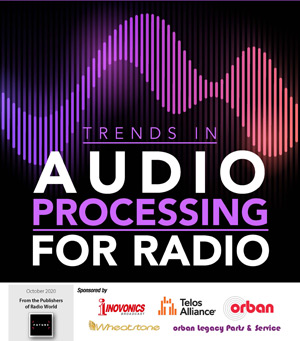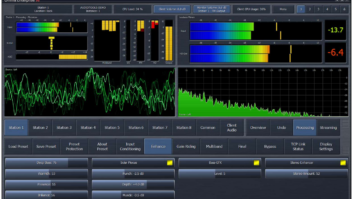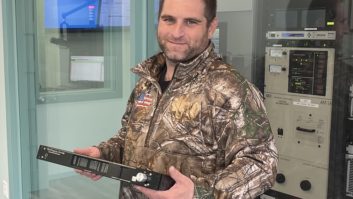
Buying a new audio processor is a huge decision for so many reasons, and some of them are less than obvious. The goal of this article is to help guide you to make (or not make) the decision to change processors.
1) Go Over Your Current Airchain — You’d be amazed how many stations I have walked into over the past four decades that had terrible airchains, and by that I mean the entire audio path, from console to antenna. Many times, program audio was fed to multiple distribution amplifiers with different gain structures as the audio passed from D/A to D/A. This adds noise, and you can easily soft (or hard) clip your program audio. That “grungy” sound may not be the processor at all.
The best way to tackle this is to do a proof of your system. Your engineer or contract engineer should be able to go through this. If distribution amplifiers are necessary, the audio feeding the processor should always come from the first.
If this decision is for your AM, the bandwidth of the antenna system adds (or subtracts) from your audio. No matter how expensive the new processor is, it will not overcome poorly maintained transmission systems. I know this only too well. Do a proof on the antenna system, whether directional or nondirectional, to observe the behavior.
Remember, the radio station works as a system. The processor is one part of it.
2) Look at Your Source Material — You could have the most immaculate airchain from the console to the antenna, with a modern AoIP system, yet still be feeding lossy audio across that beautiful system.
This is a problem I see with many classic hits and classic rock stations, where the library was digitized in the early 2000s and disk space was at a premium. That’s not the case now.

When I was in New York City, one of my missions was to improve the audio sources. I knew the airchain was virtually perfect; it was the source material that had issues. I started to keep a log of songs that didn’t sound right. Nine times out of 10 I’d pull up the file in production and, sure enough, it was either a needle drop — you’d be amazed at how many songs were digitized from vinyl — or a low-bitrate MP3.
So I worked with programming to fix this. The powers were fixed quickly; it was the secondary cuts that took longer to source and correct (and in classic hits and classic rock, there’s the chore of getting the correct version and making sure that version hasn’t been “remastered” by the God of Clipping).
Part 2 of the mission was maintaining a consistent level for commercials, imaging, jingles and music. You may have a beef with your current processor because you’re hearing it take a long time to recover from cut to cut. If there’s a 20 dB difference between spots or a spot and a rejoin element, that’s going to happen.
Luckily our production director already had that under control. But I’ve seen some studios where a bumper pins the needles on the VU and the next element barely moves them. Processors can do a lot; but they aren’t miracle workers.
In sum: Use source better material, change out what you can and keep levels in production in check. This alone can improve an audio processor’s performance and may save you from having to buy a new processor.
3) What’s Your Price Range? — My hope is that you’ve taken Points 1 and 2 seriously. But if you still need to change the processor, the next step is to determine your budget.
Twenty years ago there weren’t many offerings at bargain prices. For me this was a good thing, as I built my knowledge and reputation by designing airchains from multiple boxes you could get for-cheap online. But as technology improved and demand for inexpensive boxes that offered more grew, suddenly there were plenty of boxes in the $2,000 to $4,000 range. In many cases, the $3,500 box can sound as good as the $12,000 box, though it has less features — it may be FM-only, or may not have the analysis suite found in more expensive boxes.
Whatever your price range, I implore you to demo as many brands in that price range as possible. You may settle on a well-known brand, but don’t ignore the firepower of the new kid in town who may go that extra mile to make you happy with your purchase.
4) More Brand Considerations — Yes there are at least a half dozen brands to look at. But how are these companies with warranty and customer service?
An engineer once told me that you should call the manufacturer of each. The one that gets back to you the fastest is probably the one who will be most helpful down the line should questions or problems arise.
Knowledge is also key. There has been a reduction of force since the start of the pandemic. This slows response time. People may be laid off, but problems aren’t. It’s important to research tech support for your new investment. My rule about tech support is to treat each customer the same. You could be in Big Rapids, Mich., or Los Angeles, Calif., but if you have an off-air emergency, it’s an off-air emergency. Support should be there for you.
5) Talk to Other Engineers — If you’re working for a large company, there probably are engineers in other markets who can give you their opinions on which processors they use and what works for them. If you’re by yourself, there are still plenty of forums on social media, with many opinions about what is best for your particular situation. Which brings me to …
6) Price Range vs. Features — You can easily be swayed online towards one brand or another when you participate in one of the many social media groups. But some recommended processors may not have the features you need.
For instance, in the budget range, there are few that offer simultaneous FM/HD processing (if you’re an HD station, you probably can and should be spending more than $3,500 for your processor).
There are other things as well. Many companies shed front-panel controls in lower-priced processors, so to maximize performance, you’ll need to use the associated PC program. Others shed algorithms and use less DSP to cut costs; in other words, they take a Cadillac and cut it down to a Chevy Cruze.
As a user, you can easily get around minimized front-panel options with a PC interface. What you can’t get around is a $3,500 processor that’s a $12,000 processor with its knees cut off. The algorithms left over will not perform as intended if other features are pulled out.
If you are in the market for a top-of-the-line box, look for features like automatic HD alignment (one model has an HD tuner in it to keep the alignment within a sample), patch points for ratings encoders, signal analysis that go beyond the basic gain reduction metering you see on every processor and, most importantly, sound.
If you find your airchain really is immaculate (Points 1 and 2), it is up to the processing to add the extra flair.
7) I Want to Spend $12K to Sound Like My Competitor — This is actually somewhat infuriating to me. Your branding, imaging, talent, slogan, logo are all designed to set you apart. So why do you want your audio to sound the same as your competitor?
I was recently in a top 10 market and was astonished at how bad the audio was. Sure enough, each station had audible PPM encoding; and competing stations sounded nearly identical, with signature textures from one brand of processing. Everyone claims they want to sound better, but in the end it becomes a race to the bottom.
This is where the “hunger” comes in. Find a dealer that gives you the most flexibility to try as many boxes as you can, once you have checked off which features are important to you. You may end up with something that sounds better than the entire market.
During the demo, call the company. If you have the clout of a major market behind you, most likely they will send their guru to work with you. That’s a golden opportunity to explore what the hardware can do.
8) AoIP Suggestions — For me? The last mile should always be AES or analog. But different brands of processors use different AoIP formats, and you can stream in and out of the processors. Some AoIP solutions are brand-specific (Livewire or WheatNet), while others use third-party solutions.
If you’ve made the decision to pick a specific brand of studio gear, and if you are satisfied with that decision and have a good working relationship with the manufacturer, it’s a good idea to look at their processing line. Good customers get better prices — the worst kept secret ever.
9) Set Aside Time to Demo — the last thing you want is your processing demo to coincide with your studio move and five other projects. Get the other projects done before you tackle the audio processing. That way, you’ll devote the time needed to make the right choice, feature-wise and sound-wise.
10) Ask for Input From Staff But Know Who Makes the Decision — The needs of engineering and programming overlap in the processor. The engineer needs reliable gear that is compliant; the program director needs a processor that will allow PPM insert points, or the encoder built into the processor.
Get on the same page with must-have features and then outline what you want from the processor sonically. Just remember not to fall into the trap of Point 7.
If there is one bit of advice I can pass on to engineers for working with programming, it’s this: If the PD has the final say in what the audio will sound like, it’s all on them. They are the ones that have to lay down on the pillow every night with the station sounding the way it does.
In the minds of management, processing has a lot to do with the ups and downs of ratings (like it or not). If the PD has set the processing, they have to answer for it. If you decide, you have to answer for it. I’m not telling you who should take the lead, I’m just letting you know how it is.
In conclusion, I’ve made the decision to buy a processor a lot more complicated than you thought it should be. But I’ve been on both sides of the aisle and have set processors in every corner of the globe. The best path to your goal is not the quick one, it’s the right one. I hope this article has given you some food for thought.
Comment on this or any article. Email [email protected].
Mike Erickson is the president of WirelessMedia LLC, which specializes in matching the right processor with the right station. He worked on the manufacturing side for 10 years after spending 14 years at Infinity Broadcasting/CBS Radio in New York. He can be reached at [email protected].












